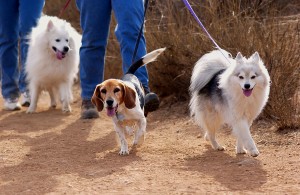Archive for the ‘dog walk’ Category
by Nancy E. Hassel, LIPetPlace.com
Dog training for Winter safety
Here on Long Island we are so lucky to be surrounded by water, have many lakes, ponds streams and natural areas to enjoy with our pets. Recently after reading a story in Newsday about a Shirley man who’s 2 off leash Husky’s ran after some geese over the thin ice of a pond and fell through. In an effort to save his dogs the owner also fell through into the cold water. The owner admitted it wasn’t too smart, not thinking the ice was too thin or the cold water too deep and found himself in, well, deep water. Thankfully this story has a happy ending where a neighbor happened to hear the man yelling for help and the man and his dogs were all rescued and are all okay. But it made me think, how many people teach their dogs not to go on the ice? It’s not something you think about every day, especially if you get adopt a puppy or dog in the spring, summer or fall. It made me think back to how I taught my first dog, and dog I currently own to be safe near ice.
When I got my first dog as an adult, a young female puppy Doberman in the late summer of 1995, I did a lot of training with her in many different places. One place more than others, happened to be a park with wooded trails, streams and a lake. That first winter, the then 8-month old puppy was very curious about the strange frozen occurrence that the lake had become. While wanting to show her the ice, I also didn’t want her to think it was safe to walk out onto. So without taking a dog training course on winter safety and going on my instincts, I let her sniff the ice, put a front paw or two on it, but never ever let her walk out onto the ice. Using various commands, “off” if she ventured more than one paw onto the ice, or “stay” to keep her by me, or using “eh ah” if she tried to step on it. Of course this was all done while she was on a leash and giving her verbal praise as a reward. I also let her step on a frozen part right near the edge that I knew would break apart, you know those couple inches of water at the edge that freeze but can still be cracked pretty easily – showing her that it would break. Doing this repeatedly throughout the winter months, trained her not to ever step out onto the ice. Each winter after that I would do a refresher near the first frozen body of water we came upon. I was lucky to have one ridiculously smart dog, who learned quickly and seemed to understand the danger. She was also trained to heel, so when in the presence of ducks, geese or any other wildlife she would not chase an animal. Of course a dog being a dog, she still had instincts to want to chase but having her trained on a verbal recall, helped in having to worry if she did get off leash near ice. I did all these same winter training rituals with my current dog, and he too learned quickly, and it didn’t hurt that he was scared of the ice to begin with. (He also learned by watching her not go on the ice.)
You also have to keep in mind what breed of dog you have too. If your dog was specifically bred for hunting, chasing out birds or is a water dog, you still want to teach your dog winter safety training. Just because your have a Chesapeake Bay Retriever doesn’t mean it can get out of a dangerous situation like falling through ice in a middle of a lake.
Winter can be a lot of fun for us and our dogs, but teaching a dog to stay, come on command and never letting your dog off leash near thin or thick ice, are vital to keeping our dogs safe – and ourselves for that matter. Now that the weather is getting cold enough for ice to begin to form across many of our lakes, ponds, and bays – think about training your dog with winter safety in mind. If you are not sure how to do this properly, consult a dog trainer and ask them for a winter safety training session or two.
Another thing a pet owner should know, whether your pet is a dog or a cat is pet first aid and CPR – especially if your pet falls through ice. We are fortunate to have a local certified Pet Tech, Robyn Elman that teaches a class in pet first aid and CPR, including what to do if your pet gets frostbite and hypothermia. The vital information taught in the class has already saved the lives of a few pets of past class participants. These pet owners who knew what to do in an emergency situation, all thanks to the information they learned in Robyn’s class. To find out more information on the upcoming January 22, 2011 class click here. Interested parties should sign up soon, as this course fills up fast and is offered about every six weeks.
by Nancy E. Hassel, LIPetPlace.com
After Thanksgiving meals are over, (leftovers and all), and the family and friends have gone home, don’t forget about your dog – who may be in desperate need of a nice long walk or hike. Dogs can get stressed out during the holidays with new noises, crowds, traveling and unfamiliar people coming and going. Help relieve that stress by going for a hike with your canine pal. Keep these tips in mind when out:
- Make sure you have your dogs appropriate collar on that has his or her name tags, license and rabies tag. Even if you are using a training collar to walk your dog, you want identification on your dog at all times. *Don’t have tags on a choke or prong collar – these are training collars that should be taken off when at home. A flat cotton, leather or nylon collar is best for dog tags.
- Use a good leash. A sturdy leather or cotton 6-foot lead is best, especially if you don’t often walk your dog. Retractable leashes are not the best if in a heavily populated park or if you have no verbal control of your dog. Your dog should be close to you, not 15 – 30 feet ahead wandering around with no direction from you. (And people coming towards you can’t see if your dog is on a leash or not and it could be unnerving for them).
- Bring water, and treats with you if you are going on a longer walk.
- Check to make sure you can legally walk your dog in the park you are planning on going to. Don’t take your dog off leash if it is not allowed, obey the park rules, and it will be a more enjoyable day for everyone.
- When approaching an oncoming dog and owner, ask if the dog is friendly and if your dog can say hello. Not all dogs are dog friendly, if you just let your dog wander up to any dog without asking, you could very well be asking for trouble. If they say no, don’t be offended, just move on.
- Don’t over do it – if your dog is primarily a yard dog, an 8-mile hike might be too much. Go for a shorter mile or two. Keep a pet first aid kit in your car also.
- Invite a friend or two with their dogs and go together, dogs like to be social and enjoy walking with their canine pals.
- If it is cold out and your dog has short hair, a dog coat will help him keep warm during the walk.
- If you live on the East End of Long Island be careful where you walk, as it is unfortunately hunting season, and often times areas where hunting is happening may not be marked. Or signs can be confusing, i.e. one sign may say, ‘Nature Preserve No Hunting’ and 50-feet away is a private game hunting area, crazy! Call your local town hall to find out more information on where you can safely walk or hike with your dog.
- Most of all have fun and walk your dog often, not just after Thanksgiving! Walking with your dog is a wonderful way to bond, work on training techniques and drain some energy both physically and mentally for your dog. You know what they say, “A tired dog is a good dog!”
Suffolk County Parks are Dog Friendly, leashed of course. Some are seasonal, click her for more info. http://www.co.suffolk.ny.us/Home/departments/parks/Parks.aspx




Categories
Archives
Blogroll
Meta